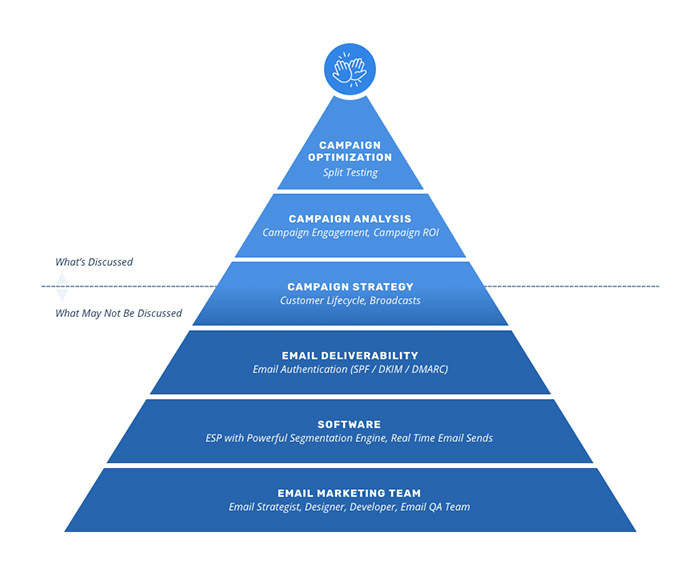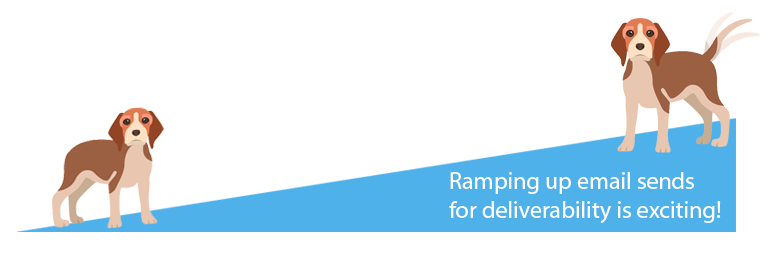December 13, 2019
Email Marketing Tips for Busy People

If you’re a small business owner with email marketing or a marketer who oversees numerous responsibilities in addition to email marketing (impossible, right?), you may feel strapped for time when implementing best practices.
For guidance, I recently reviewed HubSpot Academy’s free Email Marketing certification course, Marketo’s 8 Biggest Mistakes Email Marketers Make and How to Avoid Them, and Demand Curve’s hour-long Advanced Email Marketing webinar with Rejoiner’s founder, Mike Arsenault.
As I reviewed the resources, I noticed a few common themes. Most notably, two of the most important aspects of successful email marketing—deliverability and personalization—are both susceptible to sabotage by impatience and/or lack of time. If you indeed have limited time to spend on email, consider spending it on deliverability and personalization to maximize your investment.
Email Deliverability Is the Bottom of the Iceberg
According to Return Path, 79% of commercial emails reach the primary inbox. The remaining one in five emails end up in junk or spam folders, receive hard or soft bounces, or go undelivered. But that’s not the full story. Per Marketo:
“When email goes to a junk or spam folder, it still counts as being delivered. Yet, few of us look at or click on any of the emails that end up in our junk or spam folders. Your email deliverability rate could be 99% when, in reality, only 50% of your emails make it into the primary inbox.”
That’s why it’s important to utilize tools that measure email inboxing (Marketo plugs its own 250ok tool). But there’s also a holistic, ounce-of-prevention-type approach to avoiding the spam folder. And it begins with discussing it.
In the Demand Curve webinar, Arsenault notes the lack of regard for the topic of email deliverability amongst marketers. His company’s website features an incredibly comprehensive Email Marketing Strategy Guide that illustrates where deliverability typically ranks in the email discussion hierarchy. It’s below the surface of the iceberg:

Sticking with the ocean theme, email deliverability is like water and we marketers are the fish. With shiny objects like A/B tests, open rates, and subject lines floating around, it’s easy to forget about the fundamental importance of deliverability. But considering growing privacy concerns, stronger spam filters, and email marketing’s high return-on-investment, it’s important for marketers to re-familiarize themselves with deliverability and make it a point of discussion.
According to HubSpot, the average email contact database decays naturally by 22% per year. That’s why list maintenance is so critical. But many best practices for email deliverability occur before your contacts reach your database. Consider this list:
HubSpot’s 6 Key Components to Email Deliverability
- Obtain verifiable permission
- Use double opt-in
- Monitor hard bounces
- Conduct re-engagement campaigns
- Define a cut-off point for inactive subscribers
- Enable re-subscription
The first two components are essential. Before you send an email, you should collect consent. HubSpot also recommends creating contact lists and viewing them through the following three lenses:
- Sources (i.e., website signups vs. tradeshow signups)
- Permissions (i.e., opt-in vs. double opt-in)
- Expectations (i.e. monthly newsletter vs. weekly promo)
Doing so gives you the top-level view needed to assess the health of your email deliverability. Another helpful technique is to set expectations with subscribers from day one. For example, have your welcome email inform subscribers how many emails they can expect to receive per month.
On the Demand Curve webinar, Arsenault shares a strategy that his company employs for responsibly scaling an email program. They implement a “warm-up” period where they take their total number of contacts (their max send), start their email sends at zero, and then double their email sends every day until they reach their max send. For example, a company with 50,000 contacts would send 100 emails on day 1, 200 emails on day 2, 400 emails on day 4, and so on until they reached 50,000 emails per day. Consider it an on-ramp for deliverability.

Marketo recommends a “warm-up” approach to individual email sends. For example, stagger your send times by sending a campaign to your most engaged subscribers first and your inactive subscribers second.
If you’re sending more than 100,000 emails per month, Arsenault recommends transferring to a dedicated IP address. He also recommends using a subdomain (i.e., e.yourcompany.com) and utilizing deliverability tools such as Google’s Postmaster Tools and validation tools such as ZeroBounce or NeverBounce.
Marketo recommends separating specific email campaigns by IP address. Following these approaches along with utilizing tools like Sender Score may help lower the risks of spam traps, being blacklisted, and being marked as spam by subscribers.
The biggest takeaway to ensure consistent email deliverability is to exercise caution. Receive a hard bounce? Exercise caution and remove the subscriber. Not sure if you have consent? Don’t send the email until you can confirm. Worst case, you accidentally remove a subscriber who enjoys your emails. If so, they’ll reach out or re-subscribe.
Email Personalization Has Moved Well Past “Hi [FirstName]”
Technical aspects aside, the crux of a successful email marketing strategy is to treat others how you want to be treated. No one wants to receive unwanted emails. As a marketer, you shouldn’t want to send them. Instead, exercise patience and take time to add a personal touch at the deliverability stage. If you’re taking time to personalize deliverability, continue applying the strategy to your actual email campaigns.
In this respect, personalization means more than including a first name in the email copy or subject line. HubSpot’s course urges marketers to think of email marketing as “highly personalized nurture campaigns”. Consider where the contact is in the buyer’s journey. Are they in the awareness stage or decision stage? What content would be most helpful to them in their current stage? On the other hand, it’s important to know when not to send an email (i.e., sending a free trial to an existing customer).
Re-engagement campaigns can help, too. According to Return Path, between 25-50% of any given marketer’s lists include inactive subscribers. Re-engagement campaigns also give you the opportunity to think outside the box.
In a previous role, I developed a re-engagement campaign for April Fools’ Day. I wanted to create a subject line that would really stand out from past emails, so I created a fake product campaign for a taco holder (a taco tray that inserts into the car’s cup holder). Here's a screenshot from the "testing" shot of our product video:

Related Reading: A Fake Product Campaign Delivers Real Engagement on April Fools' Day
The accompanying subject line “Finally, a cup holder for tacos” prompted more than 200 subscribers to open an email for the first time. Intrigued by the thought of eating tacos in traffic, 25% of the subscribers clicked on the call-to-action.
Personalization can also apply to email testing. HubSpot recommends asking the following two questions before every email test: 1.) Why am I running this test? and 2.) What am I hoping to get out of it? On the Demand Curve webinar, Arsenault says he and his team take email testing to the next level of personalization. For example, they test send times by individual contact behaviors.
Other Email Marketing Takeaways
The businesses and marketers who succeed with deliverability and personalization will be the ones who exercise patience. Don’t cut steps, don’t be pushy, and don’t ever purchase lists. Do take the time to research and implement the technical aspects of deliverability and find tools that provide powerful segmentation and real-time email sends.
Outside of deliverability and personalization, HubSpot, Marketo, and Demand Curve provided additional email marketing insights. To start, Here’s Marketo's list of 8 mistakes to avoid:
Marketo’s 8 Biggest Email Mistakes
- Unclear subject lines
- Poor Email Hygiene
- Failure to measure email inboxing
- No engagement segmentation
- No re-engagement strategy
- Using image-based CTA buttons
- No mobile optimization
- Bad testing decisions
I recently consulted the owner of a professional cleaning service about his email marketing. He said his open rates were close to 60% but his click rates were below 10%. When he sent me a screenshot of one of his emails, I noticed a few things:
- Unclear subject line of "You won't believe this"
- Sent from a "support@" email address
- The email body copy needed significant work (not scannable)
- Impatient call-to-action of "Book now"
I gave the owner a few tips, some copy revisions, and a reminder to treat email marketing as "highly personalized nurture campaigns".
A Few More Insights that I Found Helpful:
- When it comes to subject lines, HubSpot recommends using 41-50 characters and avoiding words like “Free” and “% Off”. Arsenault, on the other hand, doesn’t completely avoid such words. Instead, he focuses more on building reputation.
- HubSpot recommends setting a goal for every email and connecting each piece of the email (photo, copy, etc.) to the goal. Two questions to help with setting a goal: “Is the desired outcome of the email for your benefit or your customer’s benefit?” and “How does the email fit it into other conversations you’re having with contacts?”
- Arsenault recommends sending abandoned cart emails that offer free gift, branded swag, samples, or travel size offers rather than discounts on future purchases. Speaking of discounts, he and his team find that auto-generated promo codes perform better than vanity codes. They hypothesize that auto-generated codes appear more exclusive.
- When it comes to segmentation, HubSpot employs the C.A.T.S. strategy, where sending the right Content to the right Audience at the right Time equals Success.
- For what it’s worth, Arsenault says most C-suites primarily care about email’s last-click attribution for revenue.
- If all else fails, remember this helpful mantra from HubSpot’s course: “email should be human and helpful.”
Get in touch: If you have questions, comments, or feedback about this post, shoot me an email.